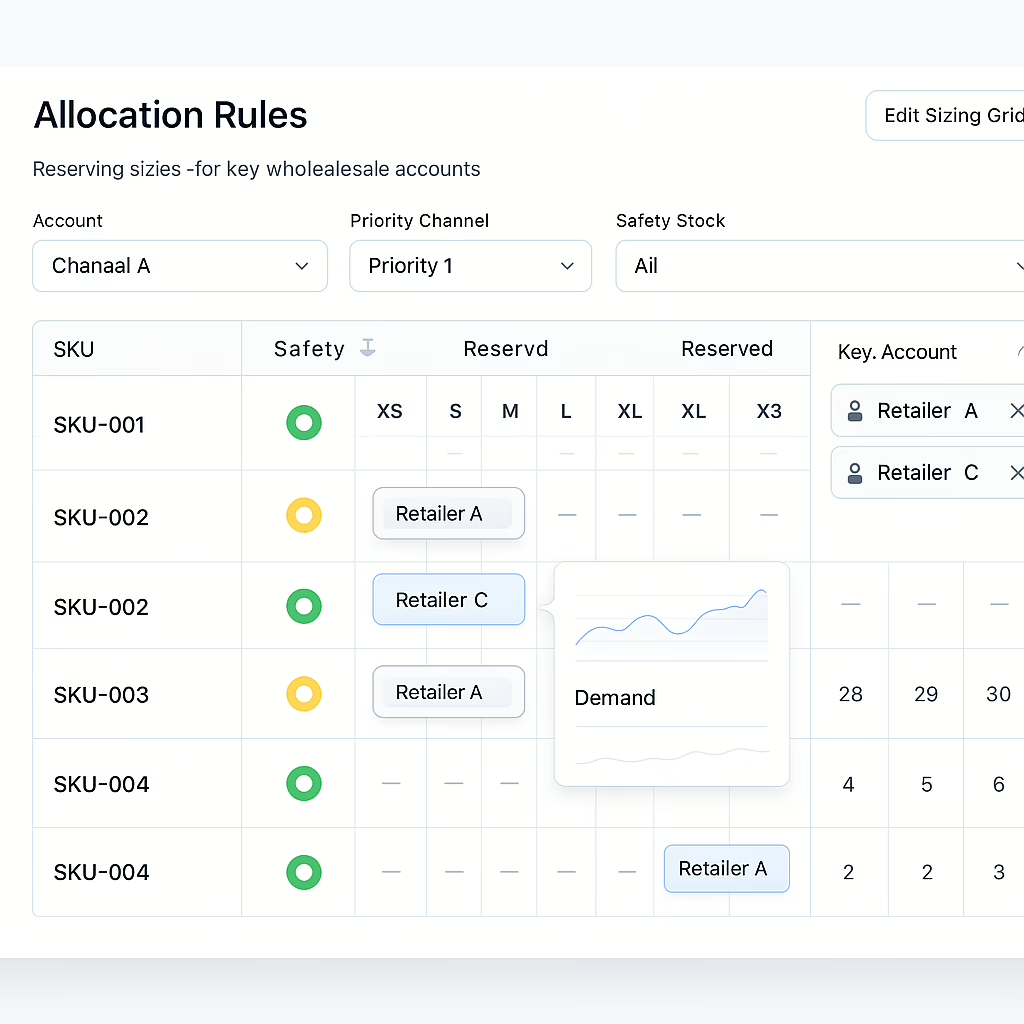
For mid-market fashion brands, managing inventory can feel like a constant balancing act. How do you prevent popular items from selling out on your website while still fulfilling large orders for your retail partners? How do you keep purchase orders moving and turn your stock into predictable revenue? The answer lies in wholesale distribution software.
This specialized software provides a single source of truth for your inventory. It syncs stock levels across all your sales channels in real time, manages complex order allocations, and automates key processes from purchase order to payment. This guide will walk you through the five most important things to look for when choosing a solution. We’ll explain how this software differs from a Warehouse Management System (WMS), and show you how platforms like Blastramp are designed to solve these exact challenges for growing fashion brands.
Key Takeaways
- Eliminate Overselling: A unified inventory system prevents you from selling the same item twice. Features like real-time syncs, stock allocation rules, and partial order shipments ensure accuracy across both B2B and direct-to-consumer (DTC) channels.
- Choose the Right Tool for the Job: A WMS is for optimizing warehouse tasks like picking and packing. Wholesale distribution software is for managing the commerce side—orchestrating orders, managing wholesale portals, and controlling the entire order lifecycle.
- Prioritize Critical Integrations: To avoid manual data entry and errors, your software must connect seamlessly with your key platforms. This includes Shopify, QuickBooks, ShipStation, EDI/3PLs, wholesale marketplaces (like Joor), and returns platforms (like Loop).
- Find Your ROI in Data: On-demand business intelligence (BI) and forecasting tools are essential. They help you track performance, reduce stockouts, shorten your cash cycle, and make smarter purchasing decisions.
- Focus on Real-World Scalability: Growing brands need an affordable, easy-to-integrate solution. Look for software for wholesale distributors that offers practical features like partial releases, automated returns, and on-demand reporting to support your growth.
What is Wholesale Distribution Software?
Wholesale distribution software is a system designed to orchestrate inventory, orders, allocations, and returns across multiple sales channels. It syncs product availability between your wholesale portal, Shopify store, marketplaces, and third-party logistics (3PL) providers. It also manages purchase orders, customer-specific pricing, and invoicing, creating a single source of truth that prevents overselling and helps you get paid faster.
This software solves common problems for fashion brands, such as stock imbalances that lead to lost sales or excess inventory. When your systems aren’t connected, a Black Friday sales spike on your website can lead to broken promises with your wholesale partners, resulting in costly chargebacks and damaged relationships. A commerce-focused system prevents this chaos.
Wholesale Distribution Software vs. WMS
A Warehouse Management System (WMS) is focused on optimizing physical warehouse operations. It improves the efficiency of picking, packing, and shipping orders and increases labor accuracy. While valuable, a WMS doesn’t manage the complexities of multi-channel sales.
In contrast, wholesale distributor software manages the business logic. It handles order rules, allocates inventory to specific channels or customers, and controls the entire journey of an order. For many mid-market brands, connecting Shopify, QuickBooks, and a 3PL through a distribution platform is a faster and more effective solution.
Wholesale Distribution Software vs. ERP
An Enterprise Resource Planning (ERP) system is a massive suite that handles a company’s core financial data and other master records. However, ERP projects are often long, complex, and expensive. Wholesale distribution software offers a more agile approach, providing the essential channel management and order rules you need without the cost and complexity of a full ERP overhaul.

Stop Overselling with a Single Source of Truth
The biggest benefit of dedicated distribution software is its ability to prevent overselling. It achieves this by unifying inventory across all channels, reserving stock for key accounts, and automatically updating availability in near real-time.
Here’s how it works:
- Real-Time Sync: Inventory levels and orders are synced across all your sales channels instantly. When an item sells on one channel, the available count updates everywhere else.
- Allocation Logic: You can reserve specific SKUs or sizes for your most important wholesale accounts. You can also set safety stock levels to create a buffer and prioritize certain channels over others.
- Partial Order Releases: If you don’t have enough stock to fulfill an entire wholesale order, the software can ship what’s available now and automatically place the rest on backorder. This keeps cash flowing and protects your service level agreements (SLAs).
- Coordinated Returns: When a customer returns an item, the software can automatically add it back to your available inventory and make it ready for reallocation. This simple workflow can significantly lift your fulfillment rates, especially during promotional periods.
Commerce-First Workflows: From PO to Cash
This software streamlines the entire sales process, from creating a purchase order to collecting payment.
- PO Orchestration: Automate your pre-booking process, create vendor purchase orders, receive advance shipping notices (ASNs), and calculate landed costs. Your finance team can see committed stock even before it arrives.
- Wholesale Portals & Rules: Publish unique price lists, payment terms, and order minimums to your wholesale portal. New orders are automatically tied to the correct allocation rules.
- Order Lifecycle Management: Orders are automatically routed to the right 3PL for fulfillment. The system handles partial releases and generates invoices and credit memos without manual intervention.
- Returns and Exchanges: Returned items are processed through automated workflows. The stock is added back to your inventory pools, and credit memos are closed out to protect your margins.
Integrations That Keep Your Business Flowing
Your wholesale distribution software is only as good as its connections to your other business systems. Prioritizing seamless, bi-directional integrations is key to reducing manual work and ensuring your finance and operations teams are always on the same page.
Look for event-driven integrations, which sync data in seconds, rather than slower batch processes that can run hours apart. The most critical connections for a mid-market fashion brand are:
- Shopify
- QuickBooks
- ShipStation & 3PLs
- Wholesale Marketplaces (Joor, NuOrder, Brandboom)
- Loop Returns
- EDI/ERP links
With the right integrations, an order from Joor can be routed to your 3PL automatically, and the corresponding invoice will sync to QuickBooks the same day.
On-Demand BI and Forecasting: The ROI Engine
Great distribution software doesn’t just manage operations—it provides the data you need to grow smarter.
- Dashboards and KPIs: Get a real-time view of your most important metrics, including fill rate, on-time in-full (OTIF) delivery, sell-through rate, aging inventory, and gross margin return on investment (GMROII).
- Forecasting: Use sales data from different channels to adjust reorders and safety stock levels. This helps you anticipate demand more accurately.
- Service and Margin Gains: This visibility allows you to make better buying decisions, reducing both stockouts and overstock situations. Many brands see a 5-10% lift in their fill rate after implementing these systems.
- Executive Reporting: Automated reports for buyers and executives provide clear insights into performance, from seasonal sales to the cash conversion cycle. This data turns operational improvements into measurable financial gains.
Pricing, Deployment, and ROI
Mid-market SaaS solutions typically range from a few hundred to a few thousand dollars per month, offering a much lower total cost of ownership than a custom ERP project. For example, Blastramp HQ starts around $750/month, while its WMS module begins near $1,500/month. This modular approach lets you start small and expand as you grow.
You can calculate the return on investment by modeling improvements in fill rate, reductions in chargebacks, and faster invoice payments. Many brands see a positive payback within months.
A typical phased rollout takes 6-10 weeks for core channels. The key to a successful implementation is starting with clean data (SKUs, size runs, and vendor information) and providing role-based training for your team.
Choosing the Right Software for Wholesale Distributors: A Checklist
Use this checklist to evaluate potential solutions:
- Capabilities: Does it offer channel-aware allocations, partial order releases, and automated RMA workflows?
- Integration Depth: Does it have event-driven connectors for Shopify, QuickBooks, 3PLs, and key marketplaces?
- Reporting: Does it provide on-demand KPIs and forecasting tools for both buyers and executives?
- Implementation: Does the provider offer a sandbox environment for testing and role-based training?
- Security & SLAs: What are the uptime guarantees and support SLAs?
Frequently Asked Questions
What is wholesale distribution software?
It’s a system that centralizes inventory, orders, allocations, and returns across wholesale, DTC, and other sales channels.
How is it different from a WMS?
A WMS manages warehouse execution (picking, packing). Distribution software manages commerce logic and multi-channel order rules.
Can it integrate with Shopify and QuickBooks?
Yes. Modern solutions offer bi-directional connectors to keep your operations and finance systems aligned.
How does it prevent overselling?
It uses real-time inventory syncs, stock reservations, safety stock rules, and partial order releases to maintain accurate availability across all channels.
How long does it take to deploy?
A typical phased implementation for core channels takes 6–10 weeks.
What does this software cost?
Pricing generally ranges from hundreds to low thousands per month. For example, Blastramp HQ starts around $750/month.
Conclusion
Fashion brands juggling stock imbalances, manual processes, and channel conflicts need a modern solution. Wholesale distribution software provides a commerce-first foundation that enforces allocation rules, prevents oversells, and turns operational data into cash. By centralizing purchase orders, allocations, returns, and integrations, this software delivers faster invoicing, higher fill rates, and a clear return on investment without the pain of a full ERP project.
Ready to end the channel chaos and protect your margins? Explore Blastramp’s integrations and see how it fits your stack: https://blastramp.com/integrations/